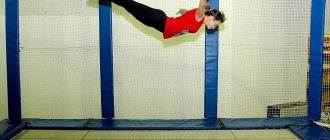The benefits of jumping rope
The most obvious benefit is the burning of calories. But it’s worth paying attention to other attractive jumping bonuses:
Improving heart function.
Jumping rope is a serious cardio workout. If you constantly do this, you can maintain good tone of the cardiovascular system. This activity will be especially useful for all those who love fatty foods.
Strengthening muscles.
No, you won’t be able to pump up your muscles, but tightening them up and strengthening them is easy. The jump rope has the greatest impact on the calves, and also has a good effect on the abdominal muscles. It also has a good effect on your arms, tightening them up. It is sagging skin and muscles that are often one of the main problems of women.
Acceleration of metabolism.
The less we move, the slower our metabolism will be. Even if the portions of food are minimal, fat deposits cannot be avoided due to a sedentary lifestyle. In addition, we can’t talk about any pumped up, toned muscles. Jumping rope is a good option to avoid these unpleasant consequences of a sedentary lifestyle. Interestingly, even after training, calories continue to be lost.
How to jump rope?
To get started, buy a jump rope that fits you perfectly. For small girls, a jump rope with a length of 210 cm is suitable, with a height of 155 to 167 cm - 250 cm, tall women up to 183 cm need a length of 280 cm, and if you are even taller, choose a jump rope with a length of 310 cm.
Start your workout with a short warm-up to warm up your muscles and avoid various injuries and damage. Perform jumps with a straight body, without rising high above the floor and landing on your toes. The main work should be done by the legs, forearms and wrists.
Handy stuff: what is muscle memory and how does it work?
Start with a slow pace that you can gradually increase. Your workout may initially last only 7-10 minutes, but over time your body will get used to the stress and you will be able to exercise for 30-40 minutes without much effort.
Alternate regular jumps with jumps with raised knees, on one leg, from side to side, with a rotation of the body, with throwing your legs back and forth - there are a lot of options. The main thing is to confidently move towards the goal and not give up on training, and then the result will not be long in coming!
Contraindications for jumping
There are not many of them and almost all of these disadvantages depend on the skills and techniques of working with it. Among them are:
- jumping increases the load on the knee joint and ligaments, so if there are any problems with these areas, then it is better to postpone training;
- Ignoring jumping technique is a direct path to severe stress on the back and lower back.
It is important to note the contraindications for jumping rope:
- Pregnancy and postpartum period.
- Asthma and breathing problems are in no way compatible with jumping.
- Joint diseases.
- Varicose veins and vascular diseases. Excessive stress on these areas will only make the problem worse.
- Obesity of the second and third degree. Jumping rope, rapid breathing, and increased stress on the heart clearly will not help you lose weight in this case. But they will only lead to additional heart problems, fainting, again, due to lack of oxygen.
- Diseases of the cardiovascular system. Before jumping, be sure to consult a doctor; some diseases allow light exercise, but there are also those for which they are prohibited.
- Diseases of the musculoskeletal system. Here it becomes clear that jumping and loading will only aggravate the person’s situation. You shouldn’t focus on jumping rope, because there are a lot of other workouts that will be effective for such diseases.
- High blood pressure. During jumping, pressure increases; with hypertension, increased pressure can cause serious complications.
Jump rope[edit | edit code]
Jump ropes
Jump rope
- sports equipment for physical exercises of adults and children. It is a synthetic or leather cord. It is used as one of the sports equipment in rhythmic gymnastics exercises. According to a survey conducted by the Russian Ministry of Health and Social Development, the most popular sport among Russians is jumping rope.
Training with a jump rope strengthens the cardiovascular system, develops endurance, and helps lose weight.
The jump rope for weight loss is used by volleyball players, wrestlers, and speed skaters. An hour of intense jumping can burn up to 1000 calories. For comparison, the elliptical cardio machine allows you to burn 700 calories in an hour.
How to choose a jump rope
There are some features in choosing a jump rope for an athlete:
- permissible diameter – from 0.8 to 0.9 cm;
- If you want to tighten your muscles faster, then you need to pay attention to a jump rope made of special plastic, which will be lighter than the usual rubber one. So you will have to put in even more effort to turn it. But to create additional load while jumping, you should choose a jump rope with weights.
How to choose the length of a jump rope? Stand in the middle of the rope with your feet, and take its ends in your hands and pull it up. The end of the rope should be at armpit level or slightly lower. If it is longer, it is more difficult to control it during exercise, and if it is too short, you need to tuck your legs in all the time.
Block four - practicing tricks with a jump rope
The duration of this part of the workout can vary greatly depending on your form, free time and training goals. With the help of a jump rope, you can develop in different directions - all exercises can be divided into four groups:
- Rope manipulation is changing the position of the arms, legs and the whole body during jumping, as well as winding and throwing. These exercises require precise coordination and attention, but require relatively little effort.
- Multi-jumps - when several turns of the rope are performed in one jump. This requires activation of explosive forces and high speed of movements. Continuous work with multi-jumps gives a high load in the anaerobic zone.
- Strength elements and acrobatics - stand-up, plank, wheel, float, somersault with a skipping rope. One of the most labor-intensive blocks. Includes elements from gymnastics and breakdancing.
- Cardio work with a jump rope. Fighters, especially boxers, often use regular straight jumps in their training, but with different foot positions. With high intensity and duration, these exercises allow you to develop endurance, attention and reaction speed.
The variety of exercises with a jump rope allows you to carry out long and interesting workouts and regularly discover something new.
How to start working with a skipping rope correctly: the basics for beginners
Start jumping and time it. Jump as much as you can, but not to the point of exhaustion. As soon as you feel that your heart begins to beat excessively or your blood pressure rises strongly, you need to stop. Some untrained people begin to feel “numbness” in their legs, this is normal and indicates that it is time to stop training or take a rest.
You can also calculate how many jumps you do at a time. For example, there will be 100 of them. Tomorrow, try to improve your own performance and jump 105 times or more, as much as you can. But in no case less than its previous result.
You can take breaks while jumping. And even necessary. Rest for about 40 seconds, then continue again. The best option for a beginner: 1 minute of jumping - 30 seconds of rest. And so on for about 30-40 minutes of training.
Example workout for beginners:
- 10 jumps on two legs;
- 10 jumps on the left leg;
- 10 jumps on the right leg;
- 20 jumps, alternating legs.
Such repetitions need to be done from 3 to 5. In this case, the break between them is 1 minute.
There is another option for training, like variety. To do this, you need to jump for 3 minutes (any jumping method you like), then there will be a minute of rest. Approaches from 3 to 5. Jumping options can be alternated.
How to diversify your workouts with a jump rope
Many people think that jumping rope is too monotonous and therefore boring. They just learned one, or at most two, variations of jumps. In fact, there are a lot of ways to jump rope.
You can mix them together, learn tricks, try double and triple jumps, and incorporate a jump rope into circuit training. Below we will look at the most common types of jumps, and then we will show four intense complexes with a jump rope.
Running in place
Run in place, raising your legs slightly off the floor. For every step, turn the rope.
Jumping with legs forward
Jump on your right leg while simultaneously bending your left knee and lifting your foot off the ground. During the second jump, bring your left leg forward. Then repeat the same on the other leg.
Boxing jumps
Boxing jumps develop endurance and help you catch the rhythm needed in the ring. When you catch it and get used to the movement, a minimum of effort is expended - this way you can jump for a long time and not get tired.
Place your feet close to each other, but do not touch them. Jump, leaving the floor low and constantly shifting your weight to one leg or the other.
Boxing jumps with alternating heel and toe
Jump on two legs, then with a jump take one leg back and place it on your toe, with the next jump move it forward and place it on your heel. Do the same on the other leg.
You can alternate every two times: toe, heel, change legs. Or after several: toe, heel, toe, heel, change legs. Jumping is great for developing coordination.
High hip jumps
These are energy-intensive jumps that will help build endurance and burn more calories. Jump from foot to foot and raise your knees high. The higher, the more difficult.
Jumping with alternating legs back and forth
As you jump, move one leg forward and the other back. Land on both feet at the same time, distributing your body weight evenly between the balls of your feet. Change the position of your feet every jump.
Jumping “feet together - feet apart”
Place your feet together. During your first jump, place your feet shoulder-width apart or slightly narrower. During the second, connect them back. Continue jumping, alternating positions.
Jumping from side to side
Place your feet together. Jump from side to side a short distance.
Jumping back and forth
Place your feet together. Jump forward and back a short distance: within half a foot from the original place.
Jumping with crossed legs
During the first jump, spread your feet shoulder-width apart, with the next jump, cross your feet. Alternate positions, placing your right and left foot in front.
Jumping rope backwards
In the starting position, the rope should not be behind you, as in regular jumps, but in front of you. Jump while twisting your wrists back so that the rope rotates in the opposite direction. This is a rather difficult movement, because you have been spinning the rope forward all your life and the body simply does not understand how to do it differently.
It is better to master reverse jumps with a heavier rope so that you can feel it flying behind you. In any case, do not try to jump higher than usual or bend at the hip joint. The movement does not require much effort, but simple habit and practice.
Jumping with crossed arms
During the first jump, cross your arms, during the second, spread them to the sides. The change of hands occurs at the moment when the rope has already passed over the head, but has not yet reached the floor.
To master this movement, first try alternating it with regular jumps. For example, two simple ones, one crossed.
Jumping with side swings
First, you need to practice doing lateral swings without jumping. Take a jump rope, place your hands close to each other and perform a figure eight from side to side with both hands at the same time.
Then try the same with jumping. Jump in place, performing a figure eight with your arms. One jump per swing to the side.
Now you can combine the movement with regular jumps. Jump once on two legs, then do two figure eight jumps and repeat.
Double Jumps
This is a complex element that will take more than one week to master. The idea is that when you jump, you rotate the rope twice instead of once. This requires greater tension in the muscles of the arms and shoulders, and high speed of movements.
It is often said that doubles must be jumped. It took at least six months before I did my first 30 doubles in a row.
I offer my way to learn double. Do two regular jumps and one double jump. Do it 10 times. Then do two regular and two double, again 10 approaches. If in some approach it was not possible to make two doubles in a row, the time does not count, and you start over. When you can make all 10, try two singles and three doubles and so on.
What should athletes do?
If it is clear that a jump rope is a good, cheap and effective friend for “non-athletes”, beginners in sports, and those who lead a sedentary lifestyle, then what about athletes? It will also be a good trainer for them!
This is one of the best ways to improve your athletic performance, and noticeable progress is especially visible for runners whose running performance is only increasing. In addition, such jump rope exercises reduce the risk of injury to almost zero.
Pros:
- all muscle groups are involved;
- “breathing” and endurance are developed, performance improves;
- a good way to warm up;
- excellent cardio load on the body;
- jumping improves coordination and balance, agility;
- improved physical fitness;
- strengthens the calf muscles;
- high energy consumption, which will help burn even more calories;
- a way to diversify your usual workouts.
An interesting study was conducted at the University of Colorado that showed that jumping rope increases bone density.
Jumping option for an athlete:
- jumping 3 minutes, rest 1 minute. Number of approaches – from 3 to 5;
- 10 jumping ropes, then rest. 20 jumping rope, rest. Add 10 jumps each time and so on until the result is 100 jumps, rest. After this, go into decline, for example, 90 repetitions, rest, 80 repetitions, rest, and so on until 10 repetitions;
- Jump at maximum speed for 20 seconds, then rest for 10 seconds. And so about 8-10 times.
At the same time, you can diversify the jumping methods by choosing the optimal, familiar or interesting ones for yourself. These may include a cross, an alternative leg jump, a toad, a basic jump, etc.
Technique for performing jumping training for weight loss
A jump rope will help you lose weight, tighten your muscles, and give your body a beautiful shape. But subject to proper training.
For exercises with a skipping rope you will need:
- Jump rope









